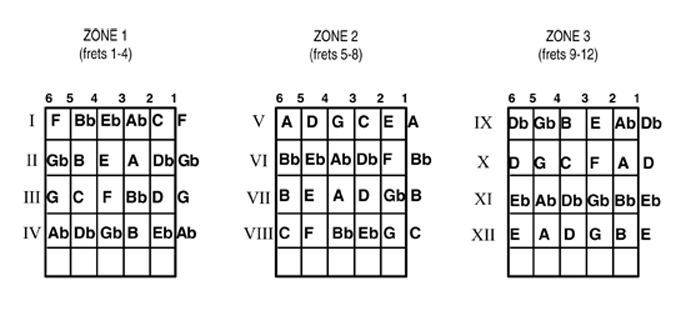Here is something that I learned from guitarist Pat Martino during a private lesson with him back in the late 70’s. At the time I was  attending Berklee College of Music in Boston. Although the harmony and arranging classes were great, my half hour weekly guitar lessons at the school left much to be desired. I was being bombarded with all sorts of harmonic concepts in classrooms filled with horn players, pianists, drummers, vocalists…and yes, several guitarists. However when I got home to my roach infested apartment overlooking Fenway Park, and sat down to practice the material, I was overwhelmed!
attending Berklee College of Music in Boston. Although the harmony and arranging classes were great, my half hour weekly guitar lessons at the school left much to be desired. I was being bombarded with all sorts of harmonic concepts in classrooms filled with horn players, pianists, drummers, vocalists…and yes, several guitarists. However when I got home to my roach infested apartment overlooking Fenway Park, and sat down to practice the material, I was overwhelmed!
If you haven’t already noticed, the notes on the guitar are organized in a very complex fashion. This is due both to its awkward tuning and the fact that we are dealing with six strings. As a result we sometimes encounter the same identical pitch in 4 different areas of the fretboard. For example, take middle C….it is available on the 2nd string /1st fret, 3rd string/5th fret, 4th string/10th fret, and 5th string/15th fret. This can initially create havoc if you are trying to master any given idea on the fretboard…not too mention sightreading! Fortunately the great Martino, very experienced, older and thus wiser than me, laid out a simple system which has stuck with me throughout my career. I call it the 3 Four Fret Zones: Zone 1 consists of frets 1-4 / Zone 2 consists of frets 5-7 / Zone 3 consists of frets 8-12 .
 The 3 zones provide a great system for the beginner through advanced student alike when it comes to organizing information on the fretboard. Beginners can use it to learn the notes in 3 chunks while more advanced players now have 3 different areas and registers to practice the art of jazz improvisation. Furthermore, if you practice all your material through the cycle of 5ths in each zone, you are guaranteed to master all the fingerings to solo in any key or register on the instrument. IMPORTANT: Keep in mind that when we practice within each 4 fret zone, this doesn’t mean that occasionally some of our fingers can’t extend into one of the other neighboring zones.What it means , especially when practicing chord voicings, is that our current root must lie inside the chosen zone! So without further adeu, here is a chart portraying the 3 four fret zones:
The 3 zones provide a great system for the beginner through advanced student alike when it comes to organizing information on the fretboard. Beginners can use it to learn the notes in 3 chunks while more advanced players now have 3 different areas and registers to practice the art of jazz improvisation. Furthermore, if you practice all your material through the cycle of 5ths in each zone, you are guaranteed to master all the fingerings to solo in any key or register on the instrument. IMPORTANT: Keep in mind that when we practice within each 4 fret zone, this doesn’t mean that occasionally some of our fingers can’t extend into one of the other neighboring zones.What it means , especially when practicing chord voicings, is that our current root must lie inside the chosen zone! So without further adeu, here is a chart portraying the 3 four fret zones:


Richie
Came across your web site. I’ve been playing GTR. a long time. I am enjoying applying your 2-5-I phrases. You have picked the cream of the crop. They are excellent.I also attended Berkley many years ago. I Wish I had a teacher of your quality during my efforts to learn jazz guitar . Any student interested in jazz guitar and having you for a teacher is very lucky. I hope they realize they got a very knowledgeable no nonsense teacher!
Thank you for the kind words…glad you are enjoying the phrases!
I would not recommend this to anyone unless it works for them, but I always include one more fret to include the stretch up. Some players prefer one fret down to include the (often absolutely necessary) drop (especially if we are improvising and realize that to include a chromatic, we have to temporarily move down one position. After open/first position, fifth position, and ninth, we often go back and catch up on third, seventh, then two four six and eight, since they are an excellent shortcut to playing in those keys we tend to avoid until we start to work with horns – or those vocalists who can never seem to sing the chart in the same key it was written in! (not their fault most of the time, but why are they so fond of F sharp and transpositions that force me to scribble Roman numerals all over the page? (LOL)